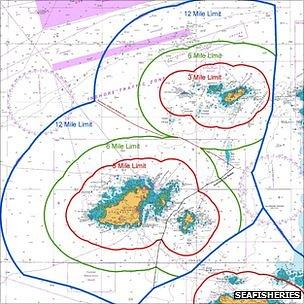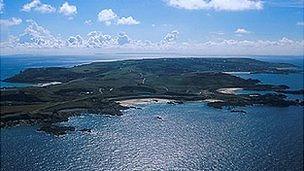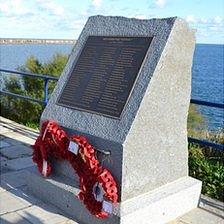Guernsey States hopes to extend territorial waters
- Published

The islands introduced the licence scheme with the aim of ensuring fish stocks are sustainable
Guernsey is looking to extend its territorial seas around the island from three to 12 nautical miles (nm), a Policy Council spokesman has said.
International discussions had been put on hold while the island introduced a scheme to control fishing in the area.
It is hoped the move could help Guernsey increase its ability to exploit renewable energy sources.
Negotiations are required with France and the UK, as well as international agreements regarding shipping lanes.
The spokesman said that before the territorial sea could be extended, the median line needed to be confirmed with France as territory could not overlap.
The 12nm limit north of Alderney waters would also include part of the English Channel's north-east bound shipping lane.
As a result, some international agreements and conventions would need to be extended to ensure the Bailiwick has the relevant protection on matters such as ensuring free passage and the management of pollution risks.
Radioactive waste
One of the reasons behind the move is the possibility of building wind farms and exploiting other renewable energy sources off the islands' coasts.
Jeremy Thompson, chairman of the States renewable energy team, has previously said putting a wind farm further out than 3nm would reduce its visual impact and allow bigger turbines to be built.

The seabed within 3nm of Alderney and Les Casquets was gifted by the Crown in 1950s
However, the leasing or buying of the seabed around the islands, which are owned by the English Crown, would also need to be decided before any projects go ahead - except for off Alderney as it owns its seabed.
The Bailiwick waters north of Guernsey and west of Alderney would also encompass the Hurd Deep.
At more than 160m (525ft) deep, the trench was used as a dump for munitions and weaponry after both world wars and for the disposal of munitions and low level radioactive waste until the 1970s.
The spokesman said assessments of the area had found the risk was low and should not impact the Bailiwick's aspiration to extend the territorial seas.
Also lying in the Hurd Deep is the wreck of the Royal Navy submarine HMS Affray, which sank in 1951 while on a training exercise and is protected as a war grave.
Search and rescue
The other two Crown Dependencies already have 12nm territorial waters.

The loss of the submarine HMS Affray claimed the lives of 75 servicemen
They were granted under a UK Act of Parliament, in 1990 for the Isle of Man and for Jersey in 1997.
Last year the licensing scheme to extend control of fishing up to 12nm of the Bailiwick was introduced.
This was "essential for the future of the island's fish stocks" according to David Cocksedge, Chairman of the Sark Sea Fisheries Committee and a Commissioner on the Bailiwick Fisheries Management Commission.
It means the islands' sea fisheries officers are responsible for patrolling the area to check anyone fishing inside the limit has a licence.
As well as monitoring fishing vessels within the 12nm limit, the islands also have responsibility for maritime search and rescue.
Guernsey's Harbour Master Captain Peter Gill said the Bailiwick, through the UK, was signed up to the Mancheplan under which France and the UK agreed to jointly respond to calls for search and rescue and work together to tackle pollution incidents.
- Published18 February 2013
- Published18 July 2012
- Published16 April 2012
- Published6 March 2012